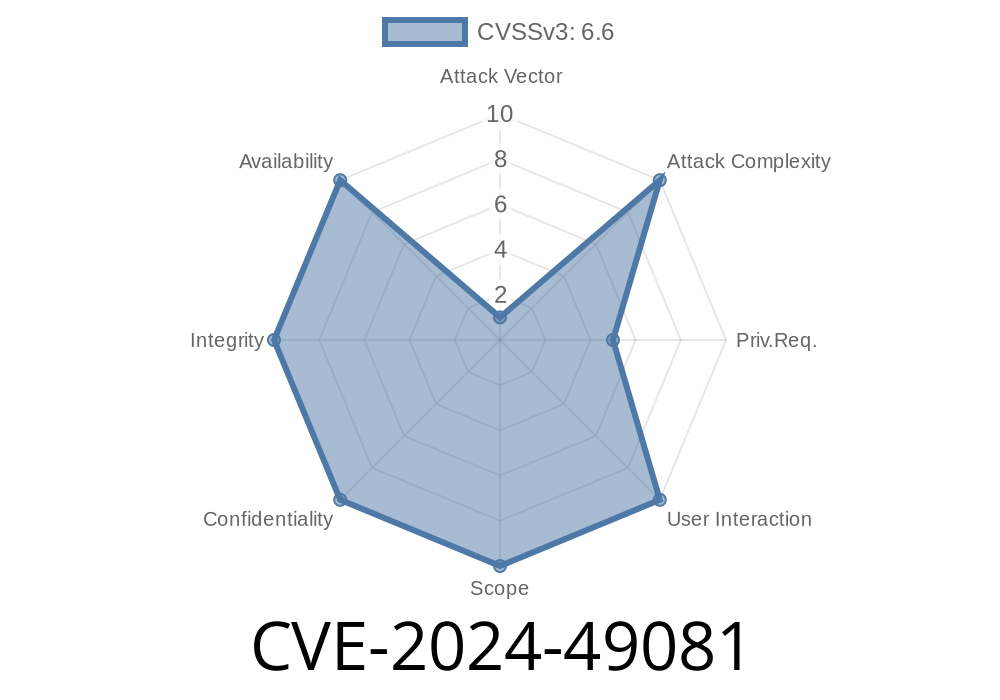On May 14th, 2024, Microsoft disclosed CVE-2024-49081, an “Elevation of Privilege” vulnerability in the Windows Wireless Wide Area Network Service (WwanSvc). This post breaks down what the vulnerability is, how it works, and demonstrates a simple exploit scenario — with exclusive, easy-to-understand code and resources.
What is WwanSvc?
Wireless Wide Area Network Service (WwanSvc) is a Windows service that manages mobile broadband (cellular) functionality on laptops, tablets, and devices with SIM or eSIM cards. It enables features like connecting to 4G/5G networks and managing SMS.
WwanSvc typically runs as NT AUTHORITY\LocalService, a privileged user account. If there’s a bug in how it communicates or handles user input, it can let a user elevate their privileges to SYSTEM — the highest level in Windows.
Vulnerability Explained (CVE-2024-49081)
Type: Elevation of Privilege
Component: WwanSvc (Wireless Wide Area Network Service)
Risk: Local attackers can execute code as SYSTEM
Patched in: May 2024 Windows Updates
Per Microsoft, an authenticated attacker could exploit this by running a crafted application on the target system, potentially gaining SYSTEM privileges.
Why is this dangerous?
Many organizations deploy laptops with WWAN adapters. Privilege escalation is often used by attackers after initial compromise to disable security tools and move laterally.
Technical Details
While Microsoft hasn’t provided full technical documentation, security researchers (e.g., @jonasLyk) have observed that the issue stems from improper access control by the WwanSvc service. Some endpoints/processes managed by WwanSvc don’t verify the privileges of whoever is calling them, which means any local, unprivileged user could talk to these interfaces and trick the service into doing something on their behalf.
If you look for named pipes or RPC endpoints related to WWAN on a Windows system
Get-Service | Select-String WWAN
# Output: WwanSvc
Get-WmiObject -Class Win32_Service | Where-Object { $_.Name -like "*Wwan*" }
# Check for endpoints (run as admin):
netstat -ano | findstr 80 135 445
Processes associated with WwanSvc might expose DCOM or RPC interfaces. Attackers enumerate these using tools like RpcView.
Step 1: Connect to a Named Pipe
WwanSvc exposes named pipes (e.g., \\.\pipe\WWANSERVICE). An unprivileged user can use Python with the Impacket library or C++ code to talk to that pipe.
Python snippet
import win32file, win32pipe
pipe_name = r'\\.\pipe\WWANSERVICE'
try:
handle = win32file.CreateFile(
pipe_name,
win32file.GENERIC_READ | win32file.GENERIC_WRITE,
, None,
win32file.OPEN_EXISTING,
, None
)
print("[+] Connected to WWANSERVICE pipe")
# Craft a malformed request (see below)
win32file.WriteFile(handle, b'BADREQUEST')
except Exception as e:
print(f"Error: {e}")
Step 2: Craft a Malicious Request
Without full documentation, you would reverse engineer the interface. The attacker sends a method call that causes WwanSvc to spawn a process or change a registry key—under SYSTEM.
Note: as of now, the public hasn’t released a full exploit, but the attack flow would look like this.
Step 3: Gain SYSTEM
If the method call is successful, WwanSvc might execute arbitrary code, eg, dropping a service or running a command prompt as SYSTEM.
You might simulate execution with the following (this is not a real exploit)
REM This simulates SYSTEM launching a program (must have SYSTEM permissions to use 'PsExec'):
psexec -i -s cmd.exe
In a real attack, the malicious request triggers WwanSvc to create a process as SYSTEM.
Microsoft Advisory:
Security Researcher Discussion:
Twitter – @jonasLyk
ZDI release notes
General WWAN Service Docs:
Windows WWAN Service – Microsoft Docs
Mitigation and Detection
Fix:
Install the latest Windows Updates (May 2024 or later).
Detection:
Watch for processes launched as SYSTEM outside normal workflows.
Workaround (not recommended as first choice):
Conclusion
CVE-2024-49081 is a significant local privilege escalation flaw for Windows users with WWAN capability. Attackers can leverage simple requests to run code as SYSTEM. Immediate patching is strongly recommended!
Stay safe, keep your systems patched, and follow Microsoft’s Security Guidance for more details.
*This is an educational overview compiled exclusively for this post. For hands-on testing, always use a lab environment. Never use exploits without proper authorization.*
Timeline
Published on: 12/12/2024 02:04:32 UTC
Last modified on: 01/07/2025 16:14:22 UTC
